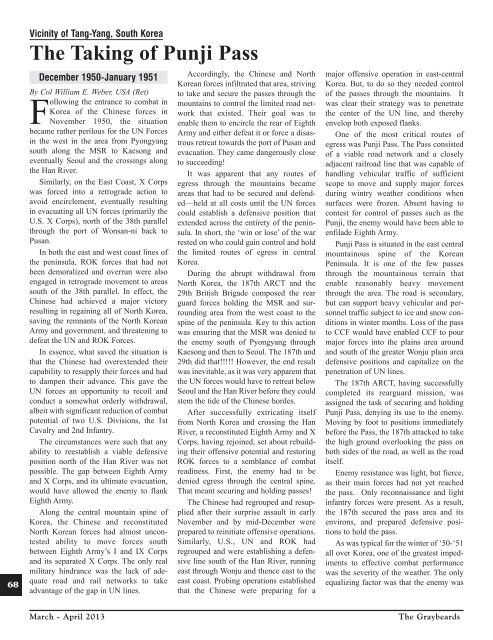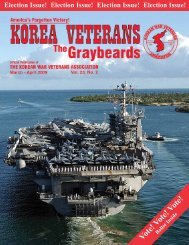Mar/Apr 2013 - Korean War Veterans Association
Mar/Apr 2013 - Korean War Veterans Association
Mar/Apr 2013 - Korean War Veterans Association
You also want an ePaper? Increase the reach of your titles
YUMPU automatically turns print PDFs into web optimized ePapers that Google loves.
68<br />
Vicinity of Tang-Yang, South Korea<br />
The Taking of Punji Pass<br />
December 1950-January 1951<br />
By Col William E. Weber, USA (Ret)<br />
Following the entrance to combat in<br />
Korea of the Chinese forces in<br />
November 1950, the situation<br />
became rather perilous for the UN Forces<br />
in the west in the area from Pyongyang<br />
south along the MSR to Kaesong and<br />
eventually Seoul and the crossings along<br />
the Han River.<br />
Similarly, on the East Coast, X Corps<br />
was forced into a retrograde action to<br />
avoid encirclement, eventually resulting<br />
in evacuating all UN forces (primarily the<br />
U.S. X Corps), north of the 38th parallel<br />
through the port of Wonsan-ni back to<br />
Pusan.<br />
In both the east and west coast lines of<br />
the peninsula, ROK forces that had not<br />
been demoralized and overrun were also<br />
engaged in retrograde movement to areas<br />
south of the 38th parallel. In effect, the<br />
Chinese had achieved a major victory<br />
resulting in regaining all of North Korea,<br />
saving the remnants of the North <strong>Korean</strong><br />
Army and government, and threatening to<br />
defeat the UN and ROK Forces.<br />
In essence, what saved the situation is<br />
that the Chinese had overextended their<br />
capability to resupply their forces and had<br />
to dampen their advance. This gave the<br />
UN forces an opportunity to recoil and<br />
conduct a somewhat orderly withdrawal,<br />
albeit with significant reduction of combat<br />
potential of two U.S. Divisions, the 1st<br />
Cavalry and 2nd Infantry.<br />
The circumstances were such that any<br />
ability to reestablish a viable defensive<br />
position north of the Han River was not<br />
possible. The gap between Eighth Army<br />
and X Corps, and its ultimate evacuation,<br />
would have allowed the enemy to flank<br />
Eighth Army.<br />
Along the central mountain spine of<br />
Korea, the Chinese and reconstituted<br />
North <strong>Korean</strong> forces had almost uncontested<br />
ability to move forces south<br />
between Eighth Army’s I and IX Corps<br />
and its separated X Corps. The only real<br />
military hindrance was the lack of adequate<br />
road and rail networks to take<br />
advantage of the gap in UN lines.<br />
Accordingly, the Chinese and North<br />
<strong>Korean</strong> forces infiltrated that area, striving<br />
to take and secure the passes through the<br />
mountains to control the limited road network<br />
that existed. Their goal was to<br />
enable them to encircle the rear of Eighth<br />
Army and either defeat it or force a disastrous<br />
retreat towards the port of Pusan and<br />
evacuation. They came dangerously close<br />
to succeeding!<br />
It was apparent that any routes of<br />
egress through the mountains became<br />
areas that had to be secured and defended—held<br />
at all costs until the UN forces<br />
could establish a defensive position that<br />
extended across the entirety of the peninsula.<br />
In short, the ‘win or lose’ of the war<br />
rested on who could gain control and hold<br />
the limited routes of egress in central<br />
Korea.<br />
During the abrupt withdrawal from<br />
North Korea, the 187th ARCT and the<br />
29th British Brigade composed the rear<br />
guard forces holding the MSR and surrounding<br />
area from the west coast to the<br />
spine of the peninsula. Key to this action<br />
was ensuring that the MSR was denied to<br />
the enemy south of Pyongyang through<br />
Kaesong and then to Seoul. The 187th and<br />
29th did that!!!!! However, the end result<br />
was inevitable, as it was very apparent that<br />
the UN forces would have to retreat below<br />
Seoul and the Han River before they could<br />
stem the tide of the Chinese hordes.<br />
After successfully extricating itself<br />
from North Korea and crossing the Han<br />
River, a reconstituted Eighth Army and X<br />
Corps, having rejoined, set about rebuilding<br />
their offensive potential and restoring<br />
ROK forces to a semblance of combat<br />
readiness. First, the enemy had to be<br />
denied egress through the central spine.<br />
That meant securing and holding passes!<br />
The Chinese had regrouped and resupplied<br />
after their surprise assault in early<br />
November and by mid-December were<br />
prepared to reinitiate offensive operations.<br />
Similarly, U.S., UN and ROK had<br />
regrouped and were establishing a defensive<br />
line south of the Han River, running<br />
east through Wonju and thence east to the<br />
east coast. Probing operations established<br />
that the Chinese were preparing for a<br />
major offensive operation in east-central<br />
Korea. But, to do so they needed control<br />
of the passes through the mountains. It<br />
was clear their strategy was to penetrate<br />
the center of the UN line, and thereby<br />
envelop both exposed flanks.<br />
One of the most critical routes of<br />
egress was Punji Pass. The Pass consisted<br />
of a viable road network and a closely<br />
adjacent railroad line that was capable of<br />
handling vehicular traffic of sufficient<br />
scope to move and supply major forces<br />
during wintry weather conditions when<br />
surfaces were frozen. Absent having to<br />
contest for control of passes such as the<br />
Punji, the enemy would have been able to<br />
enfilade Eighth Army.<br />
Punji Pass is situated in the east central<br />
mountainous spine of the <strong>Korean</strong><br />
Peninsula. It is one of the few passes<br />
through the mountainous terrain that<br />
enable reasonably heavy movement<br />
through the area. The road is secondary,<br />
but can support heavy vehicular and personnel<br />
traffic subject to ice and snow conditions<br />
in winter months. Loss of the pass<br />
to CCF would have enabled CCF to pour<br />
major forces into the plains area around<br />
and south of the greater Wonju plain area<br />
defensive positions and capitalize on the<br />
penetration of UN lines.<br />
The 187th ARCT, having successfully<br />
completed its rearguard mission, was<br />
assigned the task of securing and holding<br />
Punji Pass, denying its use to the enemy.<br />
Moving by foot to positions immediately<br />
before the Pass, the 187th attacked to take<br />
the high ground overlooking the pass on<br />
both sides of the road, as well as the road<br />
itself.<br />
Enemy resistance was light, but fierce,<br />
as their main forces had not yet reached<br />
the pass. Only reconnaissance and light<br />
infantry forces were present. As a result,<br />
the 187th secured the pass area and its<br />
environs, and prepared defensive positions<br />
to hold the pass.<br />
As was typical for the winter of ‘50-‘51<br />
all over Korea, one of the greatest impediments<br />
to effective combat performance<br />
was the severity of the weather. The only<br />
equalizing factor was that the enemy was<br />
<strong>Mar</strong>ch - <strong>Apr</strong>il <strong>2013</strong><br />
The Graybeards

















